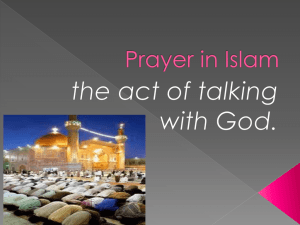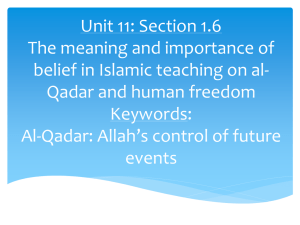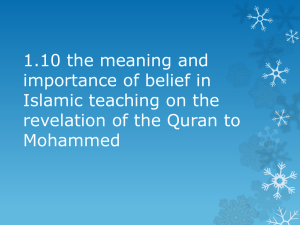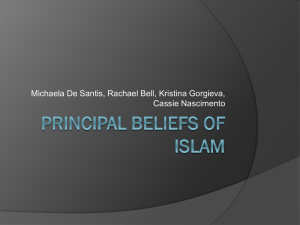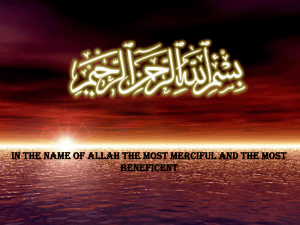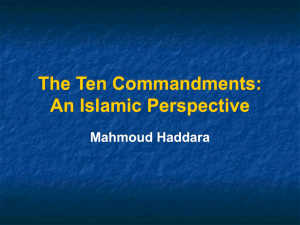TOPIC 1 INTRODUCTION TO ECONOMICS
advertisement
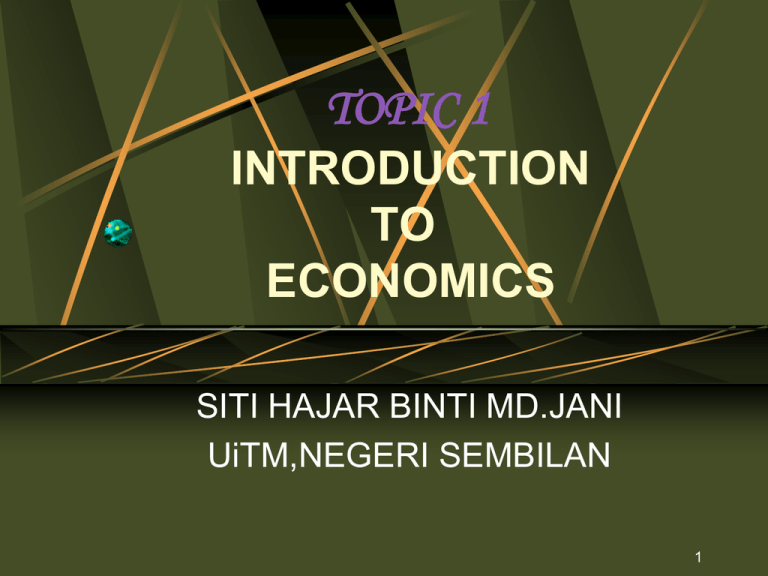
TOPIC 1 INTRODUCTION TO ECONOMICS SITI HAJAR BINTI MD.JANI UiTM,NEGERI SEMBILAN 1 DEFINITION OF ECONOMICS Economics is the study of how society chooses to allocate its scarce resources to the production of goods and services in order to satisfy unlimited wants. Irvin B. Tucker 2 Definition of Economics As “the science which studies human behaviour as a relationship between ends and scarce means which have alternative uses.” L. Robbins 3 Most economists agree that economics is: a social-science study which concerns with human behaviour in making the decision on how people use scarce resources in fulfilling their unlimited wants. 4 Definitions from Islamic Perspective Islamic economics as a social science studies which study the economic problems of people imbued with Islamic values. M.A. MANNAN 5 Definitions from Islamic Perspective Islamic economics as a study of how man can achieve al-falah (complete happiness in this world and the hereafter) through his control, ownership and uses of these worldly resources based on the concepts of co-operation and partnership. AKRAM KHAN 6 As a conclusion Islamic economics can be defined as; a study of human activities to obtain, manage and use the economic resources according to the syariah principles for the betterment of human life both materially and spiritually in order to achieve the blessing of Allah (al-Falah). 7 The Ultimate Macroeconomics objective in Islam: “is to achieve al-Falah.” All human activities and decision-making is to achieve al-Falah – to achieve the success in this world and in the hereafter. - i.e. the guarantee given by Allah s.n.t. for one’s happiness in this world as well as in the hereafter. 8 How to achieve al-Falah? To make sure that all activities and decision makings are carried out based on the philosophic foundation of Islamic economic systems which are based on the Tawhid of: i) Hablumminaan Allah: the relationship between man and his Creator Allah s.n.t. – Tawhid 9 How to achieve al-Falah? To make sure that all activities and decision makings are carried out based on the philosophic foundation of Islamic economic systems which are based on: i) Hablumminaan Allah: the relationship between man and his Creator Allah s.n.t. – Tawhid ii) Hablumminannaas: the relationship between man and his fellow men. 10 How to achieve al-Falah? To make sure that all activities and decision makings are carried out based on the philosophic foundation of Islamic economic systems which are based on: i) Hablumminaan Allah: the relationship between man and his Creator Allah s.n.t. – Tawhid ii) Hablumminannaas: the relationship between man and his fellow men. iii) The relationship between man and the Nature and his surroundings. 11 How to achieve al-Falah? To make sure that all activities and decision makings are carried out based on: the philosophic foundation of Islamic economic systems which are based on: i) Hablumminaan Allah: the relationship between man and his Creator Allah s.n.t. – Tawhid ii) Hablumminannaas: the relationship between man and his fellow men. iii)The relationship between man and the Nature and his surroundings. iv)The meaning of his living in this world. 12 i) Hablumminaan Allah: the relationship between man and his Creator Allah s.n.t. through the concept of Tawhid - the unity of thought or the unity and sovereignty of Allah s.n.t. – in Islam sovereignty in all matters belongs to Allah and to none else – a belief in an ultimate sovereignty of God. 13 i) Hablumminaan Allah: the relationship between man and his Creator Allah s.n.t. through the concept of Tawhid - the unity of thought or the unity and sovereignty of Allah s.n.t. – in Islam sovereignty in all matters belongs to Allah and to none else – a belief in an ultimate sovereignty of God. the belief and understanding that Allah is the creator, the Lord, the Sovereign, the Sustainer and the Giver. 14 i) Hablumminaan Allah: the relationship between man and his Creator Allah s.n.t. through the concept of Tawhid - the unity of thought or the unity and sovereignty of Allah s.n.t. – in Islam sovereignty in all matters belongs to Allah and to none else – a belief in an ultimate sovereignty of God. the belief and understanding that Allah is the creator, the Lord, the Sovereign, the Sustainer and the Giver. to perform the duties and responsibilities as a vicegerent of Allah s.n.t. – take good care and use of economic resources. 15 i) Hablumminaan Allah: the relationship between man and his Creator Allah s.n.t. through the concept of Tawhid - the unity of thought or the unity and sovereignty of Allah s.n.t. – in Islam sovereignty in all matters belongs to Allah and to none else – a belief in an ultimate sovereignty of God. the belief and understanding that Allah is the creator, the Lord, the Sovereign, the Sustainer and the Giver. to perform the duties and responsibilities as a vicegerent of Allah s.n.t. – take good care and use of economic resources. to totally submitting himself to Allah s.n.t. by diligently obeying His rules and 16 regulations. ii) Hablumminannaas the relationship between man and his fellow men. the responsibility of individuals to his society through the zakat. 17 ii) Hablumminannaas the relationship between man and his fellow men. the responsibility of individuals to his society through the zakat. Not to be selfish – profit earning only to a specific sufficient profitability (Responsible Profit earnings). 18 ii) Hablumminannaas the relationship between man and his fellow men. the responsibility of individuals to his society through the zakat. Not to be selfish – profit earning only to a specific sufficient profitability (Responsible Profit earnings). a balance between the requirement of material life and the well-being of the society. 19 iii) The relationship between man and the Nature and his surroundings Production activity – must consider with environmental effects and taken into account the economic welfare of the consumers. 20 iii) The relationship between man and the Nature and his surroundings Production activity – must consider with environmental effects and taken into account the economic welfare of the consumers. To ensure no wastage of resources. 21 iii) The relationship between man and the Nature and his surroundings Production activity – must consider with environmental effects and taken into account the economic welfare of the consumers. To ensure no wastage of resources. No navigation of resources to the production of unsatisfactory, low quality and forbidden goods. 22 iv) The meaning of his living in this world Fi-sabillillah. - to achieve the highest moral and spiritual benefits for all concerned. 23 What’s the difference between the conventional and Islamic macroeconomics objectives? 24 DIFFERENCES BETWEEN: CONVENTIONAL AND ISLAMIC MACROECONOMICS OBJECTIVES. Conventional economics objective is to reach maximum output with the use of scarce resources. Islamic economics tend to reach the same objective but is constrained by the Islamic ethical philosophy. 25 Conventional Macroeconomics Objectives are to achieve: i) High and stable economic growth – to increase output. 26 Conventional Macroeconomics Objectives are to achieve: i) High and stable economic growth – to maximise output. ii) Full-employment – low unemployment and high productivity. 27 Conventional Macroeconomics Objectives are to achieve: i) High and stable economic growth – to maximise output. ii) Full-employment – low unemployment and high productivity. iii) Price stability – to keep inflation low and stable value of money. 28 Conventional Macroeconomics Objectives are to achieve: i) High and stable economic growth – to maximise output. ii) Full-employment – low unemployment and high productivity. iii) Price stability – to keep inflation low and stable value of money. iv) Favourable balance of payment. 29 Fundamental Objectives in Islamic economics are: 1. Social Justice One will not abuse the power and wealth given to him for the justice of the society; since we are only the khalifah of Allah granted and being trusted to the use of ownership of the bounties given by Allah. Surah Taaha; 20:6, “He’s the one who own the bounties whatever on this earth and in the outerspace (sky) or in between or down beneath the wet earth,” for the welfare and justice of the society. and to perform his duties to pay the zakat as a voluntary duty for social justice. 30 2. Universal education make use of the education and knowledge for the betterment of human life. Higher education and skills to support productive human capital. Every Muslims were to be given the same chance to acquire education. 31 3. High rate of economic growth make use all capitals and resources which are scarce for the growth of the economy. also to consider the development of spiritual aspects of a man’s life. The qualitative aspects of the economic growth differentiate a Muslims country’s growth path with others - to include all the moral, spiritual and material aspects of human well being. to fulfill the society’s needs and to produce goods according to the hierarchy of consumption in Islam: Dharuriyat Hajiyat Kamaliyat Tarafiat (to be avoided) 32 4. Maximisation of job opportunities. to reach the best efficiency in the production and create high employment. in needs for social justice is to produce goods at the maximising revenue with high numbers of job opportunities. 33 Conclusion…… the difference between the objectives of an Islamic country to others is the pursuit of the conventional objectives to that of a Muslim country which is guided and constrained by its own ethical and Islamic philosophy. Islam as an ad-Deen that is a complete constitution that organizes all aspects of life and relationships based on the principle of Tauhid and believe that Allah is the only one. 34 DEFINITIONS OF MICRO AND MACRO ECONOMICS The words : “Micro” means small and “Macro” means large - meaning that comes from the Greek words. 35 MICROECONOMICS is part of economics that studies individual units or economic elements in the process of making decision, such as the decision made by the households, firms, government and etc. as individual units in an economy. For example, a study to look at the interaction between the producers and consumers in a market. 36 Examples of MICROECONOMICS Study Issues like the demand and supply of cars in the market in Malaysia, the production of canned pineapples by the farmers in Johor; the increase in price of sugar after a shortage of sugar cane production in Perlis, the increase in price of cloths after the government announcement of 10% bonuses to the public servants. Thus, all issues here focuses on the study of a particular specific individuals or elements towards its behaviuor and factors concern. 37 MACROECONOMICS studies the economy as a whole or deals with the economic aggregates. It concerns with the study of all individual units or economic elements together in the process of making decision in an economy as a whole. 38 Examples of Macroeconomics issues: national income, economic growth, inflation, unemployment, government deficit budget, monetary policy, balance of payment, international trade and etc. It focuses on viewing at the general structure of the aggregate components of elements in the economy as a whole. For example, the effect of aggregate expenditure on general prices and national income in the economy as a whole. 39 Thank You for lend me your ears. THAT’S ALL FOR TODAY 40
